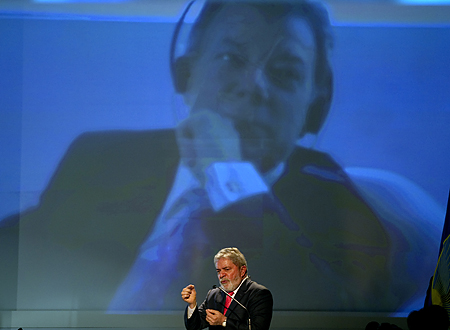
Former Brazilian President Luiz Inacio Lula da Silva, delivers a speech during the opening ceremony of the Inter-American Development Bank (IDB)-sponsored First Colombia-Brazil Investment Forum, in Bogota, on August 4, 2011, as Colombian President Juan Manuel Santos appears on the screen behind. AFP PHOTOh (Photo: Eitan Abramovic / AFP / Getty Images)
Forget The Change-Up. The best body-swapping story these days doesn’t star Jason Bateman and Ryan Reynolds; it features Uncle Sam and Latin America.
The U.S. was once the responsible (albeit imperious) adult among the two, the superpower whose politics and finances were managed more reasonably and rationally. Latin America was the petulant teen, the Third World also-ran cursed by polarized politics, fiscal recklessness and social negligence.
Now, instead of the fountain in the Bateman-Reynolds movie (they unwittingly switch bodies after peeing into a fountain during a lightning storm) have the waters of the Caribbean conjured a hemispheric flip-flop? How else to explain that the U.S. is the one acting like the banana republic, and that much of Latin America looks like the developed neighbor? It’s the U.S. that’s playing the kind of dysfunctional, zero-sum politics that poisons economies and finances; it’s Latin America that’s moving to the political center and finding the successful compromises between capitalism and socialism. It’s the U.S. where growth may be anemic for a long time and the wealth gap is widening at an alarming rate; it’s Latin America that grew more than 6% last year and is finally seeing its middle class rise, even in once epically unequal countries like Brazil.
Of course one shouldn’t take this Hollywood conceit too far. Latin America is certainly still a developing region and it’s certainly still haunted by pockets of ideological politics. But left-wingers like Venezuelan President Hugo Chávez and right-wingers like Panamanian President Ricardo Martinelli are for once the exceptions. The Latin role models today are moderates like former Brazilian President Luiz Inácio Lula da Silva – whose business-friendly, poverty-busting pragmatism is being emulated not just by fellow liberals like Salvadoran President Mauricio Funes but conservatives like Colombian President Juan Manuel Santos. The latter’s approval rating hovers over 70% thanks to improved security and robust growth in civil war-torn Colombia, but also to his commitment to improving its appalling labor rights situation and income disparities.
Meanwhile, in the U.S. we have the Third World spectacle of what was once the world’s most respected legislature reduced to the most ridiculed. Like some equatorial parliament from a Graham Greene novel, our Congress has been hijacked by Tea Party and MoveOn.org wing-nuts, whose juvenile dogmatism regarding revenue increases and entitlement reductions just brought us to the brink of the kind of debt default we once derided in countries like Uruguay. Now, after America’s S&P downgrade, they’re mocking us in Montevideo, where center-left Uruguayan President José Mujica has put aside his radical guerrilla past to guide one of South America’s most impressive economic recoveries. Examples like his, in fact, make our own centrist President, Barack Obama, look all the more ineffectual.
On foreign policy, U.S. conservatives like the Tea Partiers love to rage at Latin leftists like Chávez, but in reality they’re mirror images of him. Ditto U.S. liberals like the Pelosi-ites when it comes to Latin rightists like Martinelli. They all inhabit the same self-righteous, hyperpartisan universe where every day has to be a revolution, a political Armageddon that gives them an easier warrior high than the genuinely heroic work of bipartisan compromise does. These days, Chávez and Martinelli are reminders not of how different the U.S. is from places like Latin America, but of how much like them the U.S. is becoming in the 21st century, as we melt down over the loss of our golden 20th century.
Today the prosperity buzz in the Americas is focused on countries like Peru, an Andean nation that not so long ago was synonymous with political and financial chaos. Last year its economy grew 8.8%, and it’s poised to top 7% this year. Just as important, its chronically feckless leadership is growing up. After bankrupting Peru during his first leftist presidency in the 1980s, Alan García made amends during his more sensible second act as President, which ran from 2006 until last month. His successor, Ollanta Humala, was once a Chávez acolyte who, after losing to García five years ago, ran as a moderate this year and has promised to be a practical steward of Peru’s boom, a pledge his recent cabinet appointments seem to back.
So what kind of hemispheric fountain are we standing in where Peru appears to be the sober showcase and the U.S. – where last month Florida’s Tea Party Governor Rick Scott tacitly advocated risking a national default when he urged Washington not to raise the federal debt ceiling – has the role of the unhinged problem child? Where it’s the Americans, not the Argentines, who repeatedly watch their salaries and savings being blindsided by the arrogant idiocy of their extremist government officials and fat-cat corporate bosses? Right now, Uncle Sam, you are the banana republic.

